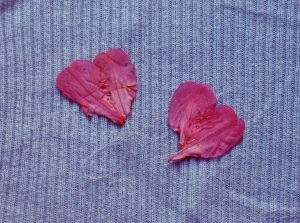During a trip to England in spring 1998 I visited Exeter, staying on the campus of Exeter University in a rather cheerless dormitory. There was a storm in the night and, by morning, hundreds of red and pink Rhododendron blooms had fallen from the bushes lining the campus pathways. The blooms touched me, as they were still so beautiful, even those that had completely broken. I collected some of the damaged blossoms and returned to my room, where I stitched them back together. Some petals I sewed into hearts:
While other petals I attempted to recreate, with thread, as blossoms:
I also made a flower-mending kit, re-purposing the in-room sewing kit:
… which I left for the next guest or, more likely, the cleaning staff. Then I took my “mended” blossoms back outside, and reattached them to the Rhododendron bushes with thread:
This work began to feel like something fairies might do if they were so inclined. Who else would mend a flower and return it to its growing home? There were still many fallen blossoms, which by now felt like a creative resource or opportunity I could not miss. I filled my bag and went to the city’s best-known architectural “icon,” Exeter Cathedral of St Peter (opened 1400).
Beautiful photograph by Rüdiger Wölk.
On the day I visited, the weather was much moodier than in the photograph above, and the light was pale and cool. My only intent was to use these flower blossoms as a way of leaving a mark on a famous work of architecture, in such a way that would not be destructive, but would temporarily transform or supplement the space of the building. Exeter Cathedral is large, almost overwhelmingly so for a person attempting to make a small but visible difference. Like the exterior, the interior is filled with sculpture, statuary, and carving. I was taken with the alabaster effigy of Bishop Edmund Stafford (1344-1419), created in the 19th century. The Bishop’s nose has rubbed away from many years of touching, for luck I presume, while others have left their trace in the form of graffiti, even on his cheeks. My intervention was gentler.
Although polychromy was later added to the effigy via the decorative plinth and screen seen above, the form of the Bishop himself was without colour. Battered, stern, grimly representing the order and patriarchy of the Catholic Church, the Bishop seemed in need of a lively jolt of colour and organic matter. Perhaps also a little stereotypically “feminine” touch, too.
I think he was much improved by the addition of the fallen blossoms. One of the wonderful things about working creatively with churches is that, unless one is actually being destructive, one’s odd actions may fall to some extent under the category of pilgrimage work, or honouring a saint or holy figure. My foray into Exeter Cathedral had nothing to do with these practices in terms of intent, but they did allow me a cover of sorts. No-one stopped me or asked what I was doing, although I was ready to explain.
My work continued outside, with more blossoms, this time using and responding to the architecture of the building.
My gestures at Exeter Cathedral and Exeter University were ephemeral in nature, and would probably not survive more than a few days at most before being cleared or blown away. My research at this time was exploring the potential of such gestures to create a small space of questioning, or musing, perhaps for some even delighted surprise. Who did this? Why? And I was, as the title of the project suggests, inspired by my reading at the time about fairies, especially Katharine Mary Briggs’ book, The Anatomy of Puck (1977) and the work and life of Robert Kirk (1644-92). Kirk was a Scottish Episcopalian minister who, despite the obvious contradictions, saw and wrote about fairies, elves, second sight, and all sorts of fascinating things in his book, The Secret Commonwealth, published more than two centuries after his death. Very worth reading. Here is an image of the front cover of the first edition (1893), of which only about 500 copies were made:
Fairies, according to such sources, were not much like the wasp-waisted, mini-skirted, flirtatious Tinkerbells of contemporary, Disney-saturated imagination. They were, rather, curious and often ambivalent or even malevolent beings, existing somewhere between human and angelic world in the elemental realms of earth, fire, water, and air. They were, as far as appearance goes, unpredictable. A cow out of place might actually have been a fairy, waiting to turn your milk sour (a favorite past-time of the fairy world), or to rescue other cows from a stray curse. Of course, cows do not pop up here and there the way they once did. Is it possible, then, that fairies have had to work their half-magic in other ways, perhaps even through people? Kirk does write of possessions of a sort. Kirk also wrote fondly if sometimes exasperatedly of how fairies hid his pencils while he was trying to write his manuscript, or blew out his candle just as he was getting into some work.
During the period that I was exploring the fairy as a concept with a history and a history of representation, I too was similarly besieged by missing pencils, but I was also inspired to take action as an artist in different ways than I had in the past. Enchanted by the idea that fairies were able to slip in and out of human spheres of experience and meaning, leaving little marks and gestures behind them, I also loved that fairies – at least as Briggs and Kirk had presented them (see also: Shakespeare) – seemed so fearless. And so, during my time in Exeter I was a feminist artist using flowers – a heavily overdetermined signifier in terms of femininity – and a fairy, causing a little mischief, helping out the natural world, leaving a quixotic trace behind me.












